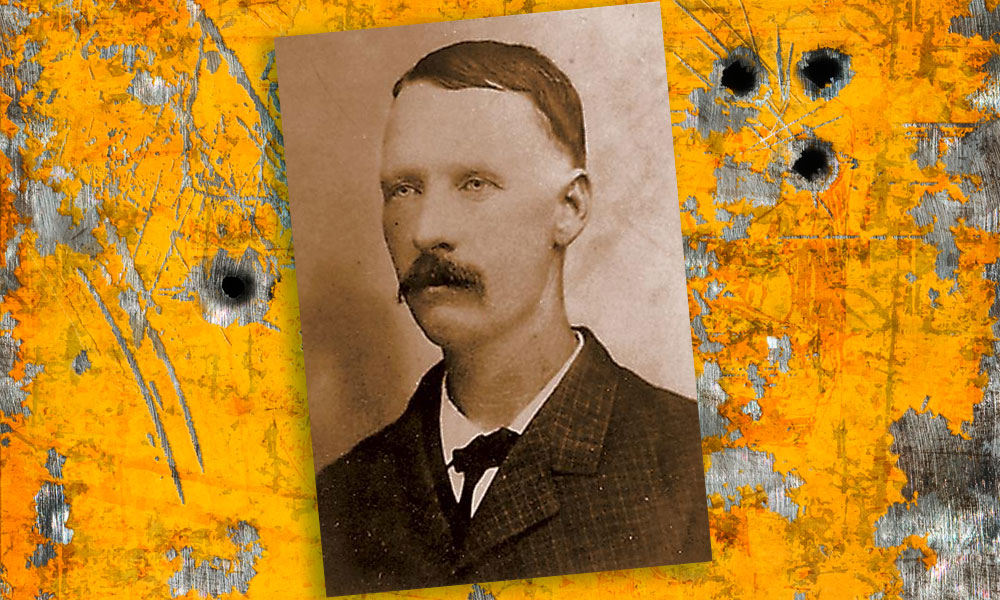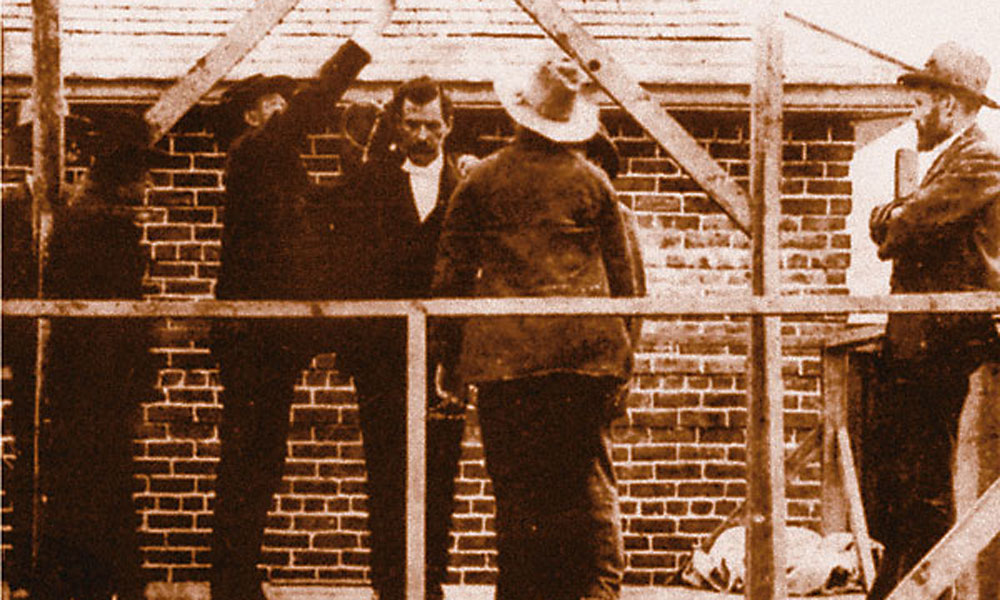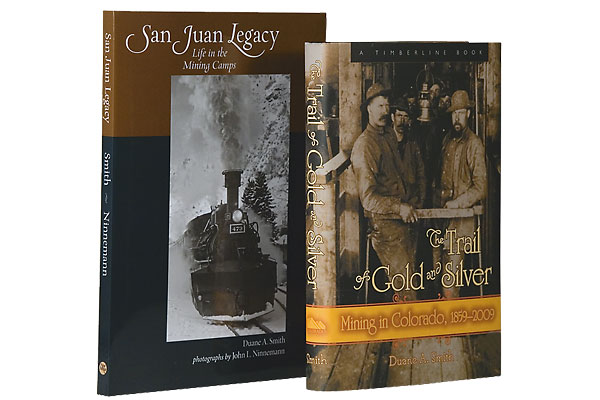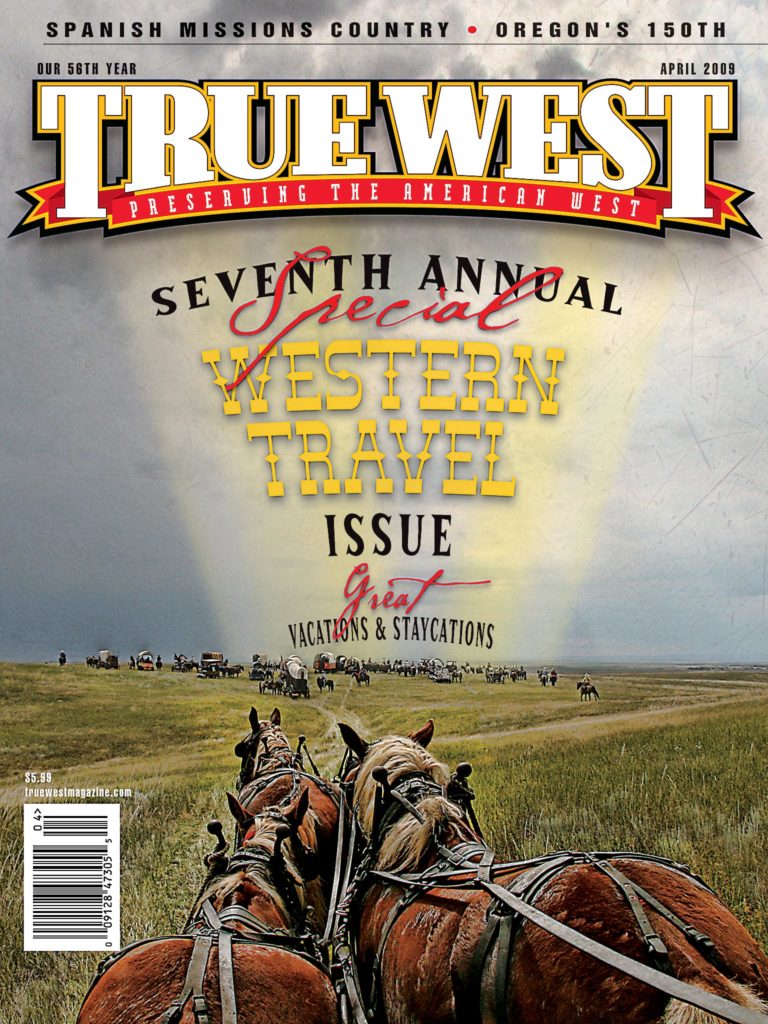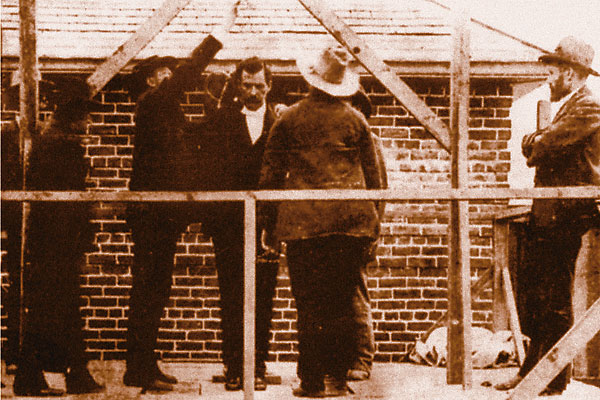
August 16, 1899
Camped in a cave, two miles south of Folsom, New Mexico, Tom Ketchum waits until dark, then mounts up
He leads a pack horse carrying his safe-blowing kit. The outlaw rides to a spot on the Colorado & Southern Railroad tracks, hitches his horses, builds a fire and starts walking toward Folsom.
It is 10:20 p.m. and the southbound train No. 1 is running 10 minutes late. When the train reaches him, Ketchum climbs in the cab of the engine and sticks the barrel of his pistol in the engineer’s ribs, ordering Joseph H. Kirchgrabber to stop the train at a point four miles south of Folsom.
The train is stopped on a curve with a four-foot high embankment (two miles short of Ketchum’s campfire). Ketchum orders the engineer out of the cab, but Kirchgrabber refuses.
“You son of a bitch, I’ll kill you,” threatens Ketchum, pushing his Winchester into the trainman’s armpit before adding, “I’ll shoot if you don’t.”
The engineer coolly defies him: “Shoot away.”
Ketchum turns his attention to the fireman, Tom Scanlon, who steps down with no argument and leads the outlaw to the door of the express car.
Hearing a banging on the door, express car messenger Charles P. “Scotty” Drew opens the door and finds himself looking down the barrel of Ketchum’s Winchester.
“Fall out of there goddamn quick,” the outlaw snaps; Drew complies. While Drew holds a lantern, Scanlon is ordered to uncouple the express car from the coal tender. He has difficulty doing so as the cars are attached via a coupling device, called a “Miller hook,” which is programmed to lock whenever a train is halted on a curve.
Several times, mail clerk Fred Bartlett peeks out from the mail car (the second car, back from the coal tender). Spotting his head, Ketchum barks, “Get back in there!” as he also fires a warning shot that glances off a steel brace on the car and ricochets through Bartlett’s jaw, taking out two teeth. He falls, face forward, onto the floor of the car.
Finally, Scanlon tells the outlaw he has uncoupled the cars. But when the three return to the engine, they discover the train will not budge. Scanlon merely cut the air hose that sealed the brakes on all the coaches behind the express car.
Angry, and on edge, Ketchum says to the engineer, “If you don’t come back there, I’ll kill you. I want you to cut the baggage car off.”
This time, Kirchgrabber complies and sets to work uncoupling the car.
Meanwhile, in the back of the train, conductor Frank Harrington (who has been robbed twice before on this same run) unpacks his shotgun, assembles it and walks through the cars. Slowly losing his nerve, he comes upon Bartlett, who is moaning and muttering that he is “bleeding to death.”
Harrington resolves to “kill somebody or be killed himself.” Peering out the end door, he sees four men standing below him. He throws the door open and fires from the hip. Instantly, Ketchum reacts and starts to shoot, but as he turns, 11 buckshots strike the outlaw above the right elbow. Ketchum’s bullet nicks Harrington’s left sleeve, as the outlaw is knocked off his feet and tumbles down the embankment.
The train crew scrambles for safety, while Ketchum stumbles up the bank and reels across the tracks in front of the locomotive. He takes a couple potshots at the lantern, his bullets thudding into the side of the mail car. Then he’s gone.
The train crew dresses Harrington’s wound and fixes the brake system, and 35 minutes later skedaddles down track to Clayton and safety. A hundred yards north of the tracks, Ketchum collapses. He, too, will eventually make it to Clayton, where he remains to this day.
Ketchum’s Final Run
Born in Texas in 1863, the youngest of three boys, Tom Ketchum fled to the Pecos Valley of New Mexico where he cowboyed until joining his brother Sam in 1894. The duo went on a crime spree: robbing stores, stagecoaches and trains. During their escapades, the press tagged Tom as “Black Jack,” but it’s likely that his fellow gang members never called him that. Tom’s final chapter included:
September 3, 1888
Four men (including both Ketchums), all riding bay horses, rob the Texas Flyer in a shallow cut, south of Folsom, New Mexico, on the Colorado & Southern Railroad line. They steal a repoted $3,000. Historians speculate that a fight over splitting the spoils results in Tom being kicked out of the gang.
July 11, 1899
Two outlaws, Elzy Lay and Sam Ketchum, commandeer Train No. 1 south of Folsom. Sam tells the engineer to “stop where the last holdup was.” This time, four outlaws ride off with some $70,000. Tom Ketchum is not with them.
July 16, 1899
A Cimarron, New Mexico, posse attacks the Folsom train robbers in Turkey Creek Canyon, badly wounding both Elzy Lay and Sam Ketchum. Outlaw Will Carver holds off the posse, killing two. The outlaws escape, although Sam is captured the next day and dies of blood poisoning on July 24. (Elzy Lay will be captured four weeks later, on August 16.) Tom Ketchum is not with them.
August 16, 1899
Unaware of the train holdup and the gunfight in July, Tom Ketchum fails to rob the Colorado & Southern Railroad near Folsom. The wounded outlaw makes it back to his camp, but he cannot mount his horse.
August 17, 1899
In the morning, Ketchum flags down a northbound freight, carrying Sheriff Saturnino Pinard, who arrests him. At Folsom, a railroad physician bandages Tom’s shattered arm while an angry mob threatens to lynch the outlaw. The mob is dispersed, and Ketchum is taken to the nearest hospital, located in Trinidad, Colorado.
Aftermath: Odds & Ends
Both Tom Ketchum and the badly wounded Fred Bartlett were treated in the Mount San Rafael Hospital. On August 21, Deputy Sheriff George Titsworth, who had just learned how to operate a camera, took two photos of Ketchum, one with his beard and the second without. (Ketchum refused to pose for the second photo until someone gave him a pistol to hold.)
***
Joining the just captured Elzy Lay, Tom Ketchum and Lay were taken by train to the penitentiary in Santa Fe. On September 2, Ketchum’s infected arm was amputated. Not long after, he was taken to Clayton, where he was tried, convicted and sentenced to hang. On October 5, 1900, Ketchum made the long drop (during which his head snapped off), and he was buried in the Clayton cemetery.
***
Recommended: The Deadliest Outlaws by Jeffrey Burton, published by Palomino Books.


